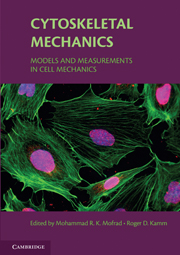Book contents
- Frontmatter
- Contents
- List of Contributors
- Preface
- 1 Introduction, with the biological basis for cell mechanics
- 2 Experimental measurements of intracellular mechanics
- 3 The cytoskeleton as a soft glassy material
- 4 Continuum elastic or viscoelastic models for the cell
- 5 Multiphasic models of cell mechanics
- 6 Models of cytoskeletal mechanics based on tensegrity
- 7 Cells, gels, and mechanics
- 8 Polymer-based models of cytoskeletal networks
- 9 Cell dynamics and the actin cytoskeleton
- 10 Active cellular protrusion: continuum theories and models
- 11 Summary
- Index
8 - Polymer-based models of cytoskeletal networks
Published online by Cambridge University Press: 10 November 2009
- Frontmatter
- Contents
- List of Contributors
- Preface
- 1 Introduction, with the biological basis for cell mechanics
- 2 Experimental measurements of intracellular mechanics
- 3 The cytoskeleton as a soft glassy material
- 4 Continuum elastic or viscoelastic models for the cell
- 5 Multiphasic models of cell mechanics
- 6 Models of cytoskeletal mechanics based on tensegrity
- 7 Cells, gels, and mechanics
- 8 Polymer-based models of cytoskeletal networks
- 9 Cell dynamics and the actin cytoskeleton
- 10 Active cellular protrusion: continuum theories and models
- 11 Summary
- Index
Summary
ABSTRACT: Most plant and animal cells possess a complex structure of filamentous proteins and associated proteins and enzymes for bundling, cross-linking, and active force generation. This cytoskeleton is largely responsible for cell elasticity and mechanical stability. It can also play a key role in cell locomotion. Over the last few years, the single-molecule micromechanics of many of the important constituents of the cytoskeleton have been studied in great detail by biophysical techniques such as high-resolution microscopy, scanning force microscopy, and optical tweezers. At the same time, numerous in vitro experiments aimed at understanding some of the unique mechanical and dynamic properties of solutions and networks of cytoskeletal filaments have been performed. In parallel with these experiments, theoretical models have emerged that have both served to explain many of the essential material properties of these networks, as well as to motivate quantitative experiments to determine, for example concentration dependence of shear moduli and the effects of cross-links. This chapter is devoted to theoretical models of the cytoskeleton based on polymer physics at both the level of single protein filaments and the level of solutions and networks of cross-linked or entangled filaments. We begin with a derivation of the static and dynamic properties of single cytoskeletal filaments. We then proceed to build up models of solutions and cross-linked gels of cytoskeletal filaments and we discuss the comparison of these models with a variety of experiments on in vitro model systems.
Introduction
Understanding the mechanical properties of cells and even whole tissues continues to pose significant challenges. Cells experience a variety of external stresses and forces, and they exert forces on their surroundings – for instance, in cell locomotion.
Information
- Type
- Chapter
- Information
- Cytoskeletal MechanicsModels and Measurements in Cell Mechanics, pp. 152 - 169Publisher: Cambridge University PressPrint publication year: 2006
Accessibility standard: Unknown
Why this information is here
This section outlines the accessibility features of this content - including support for screen readers, full keyboard navigation and high-contrast display options. This may not be relevant for you.Accessibility Information
- 8
- Cited by
